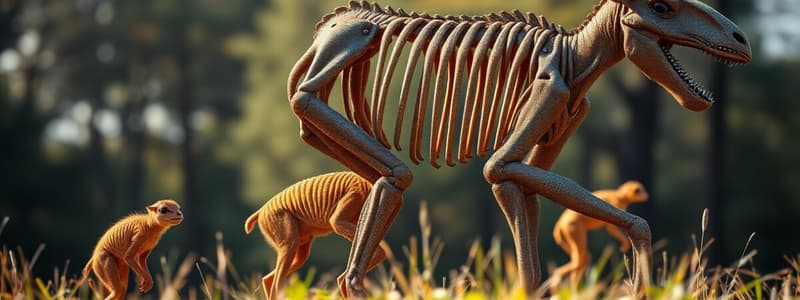Podcast
Questions and Answers
Which concept describes the process where advantageous traits become more common in a population over generations?
Which concept describes the process where advantageous traits become more common in a population over generations?
- Comparative Anatomy
- Theory of Natural Selection (correct)
- Theory of Use and Disuse
- Theory of Acquired Characteristics
According to the Theory of Use and Disuse, what would happen to an organism's organ that is not used?
According to the Theory of Use and Disuse, what would happen to an organism's organ that is not used?
- It would get passed on to offspring.
- It would evolve into a new organ.
- It would disappear. (correct)
- It would remain the same.
Which of the following contributes least to the evidence supporting evolutionary relationships between species?
Which of the following contributes least to the evidence supporting evolutionary relationships between species?
- Theory of Use and Disuse (correct)
- Comparative Anatomy
- Genetic Information
- Fossil Evidences
A population of birds colonizes a new island. Over time, birds with larger beaks become more common due to their ability to crack open the tough seeds available on the island. Which of the following best explains this observation?
A population of birds colonizes a new island. Over time, birds with larger beaks become more common due to their ability to crack open the tough seeds available on the island. Which of the following best explains this observation?
An athlete trains extensively and develops larger muscles. According to the Theory of Acquired Characteristics, what would happen?
An athlete trains extensively and develops larger muscles. According to the Theory of Acquired Characteristics, what would happen?
Flashcards
Who is Charles Darwin?
Who is Charles Darwin?
The English naturalist who developed the Theory of Natural Selection.
Natural Selection
Natural Selection
Offspring inherit helpful traits, adaptive characteristics become common, and poorly adapted individuals die off.
Theory of Adaptation
Theory of Adaptation
Organisms change in response to their environment.
Theory of Use and Disuse
Theory of Use and Disuse
Signup and view all the flashcards
Theory of Acquired Characteristics
Theory of Acquired Characteristics
Signup and view all the flashcards
Study Notes
- The lesson covers the evidence for evolution
Objectives
- Explain the occurrence of evolution
- Explain how fossil records, comparative anatomy, and genetic information provide evidence for evolution
Evolution
- Evolution refers to a change in organisms over time
- The earliest creatures are no longer around because as the environment changes, living organisms change to adapt
Theories of Evolution
Charles Robert Darwin
- Charles Robert Darwin (1809-1882) was an English naturalist and geologist
- Darwin developed the "Theory of Natural Selection"
- Natural Selection posits the survival of the fittest
- With natural selection the offspring are born with their parents' helpful traits
- Adaptive characteristics prevail in more of the species, but individuals that cannot adapt die off
Jean-Baptiste de Lamarck
- Jean-Baptiste de Lamarck (1744-1829) was the first evolutionist who believed organisms change over time
- Lamarck developed three theories
- Theory of Need- organisms change in response to their environment
- Theory of Use and Disuse - If a body structure is used often, it will develop further, but organs not in use will disappear
- Theory of Acquired Characteristics - Animal characteristics acquired during its lifetime to adapt to the environment can be passed to its offspring
Evidences of Evolution
- Fossil Evidences
- Fossil evidence provides a preserved physical remain of organisms that provides a narrative of organisms' evolution over millions of years
- Types Of Fossilization include carbon dating
- Comparative Anatomy
- Comparative anatomy studies similarities and differences in the structure of organisms
Homologous vs. Analogous Structure
- Homologous Structure
- Leads to divergent evolution where species perform different functions in the environment or may have the same origin but different roles in the the environment
Analogous Structure
- Leads to convergent evolution and has similar functions with different origins
-
Structures of unrelated species may evolve to look alike because they adapt to similar functions
Compression and impression
-
Compression involves the flattening and preservation of organic material under pressure, creating a two-dimensional representation of the organism.
-
impression fossils are formed when an organism leaves a distinct mark in sediment, capturing its shape without any preservation of the actual organic material. Both methods provide valuable insights into past life and geological conditions.
-
Studying That Suits You
Use AI to generate personalized quizzes and flashcards to suit your learning preferences.




